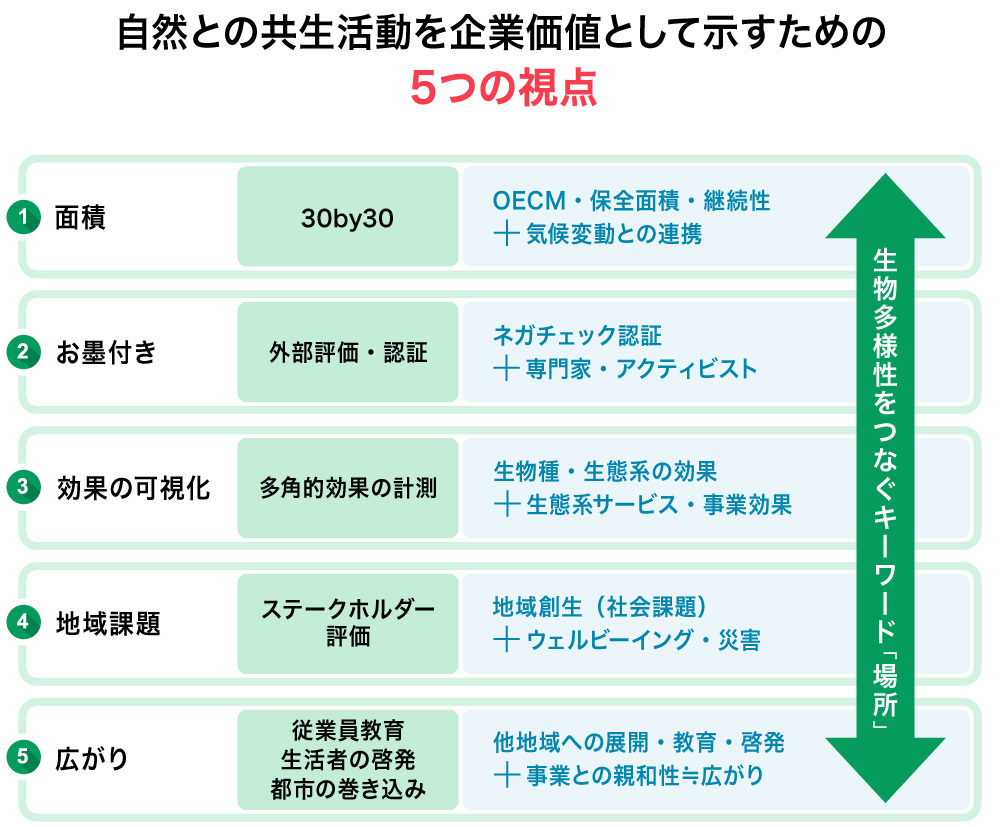"We are engaged in biodiversity conservation, but it hasn't translated into corporate value."
"We're being asked about the investment returns of our long-standing environmental activities and how they connect to our business."
In Japan, biodiversity gained attention as a social issue around the time of the 2005 Aichi Expo. Globally, many companies have also been engaged in biodiversity-related activities for years. However, pioneering conservation efforts don't necessarily translate to competitive advantage today. Amid cost-cutting pressures, sustaining these activities becomes difficult. Many companies face the challenges mentioned earlier—including difficulty explaining why they've pursued these efforts for so long.
Furthermore, starting with the fiscal year ending March 2027, sustainability disclosure will become mandatory in the securities reports of some major Japanese companies, with the scope of affected companies set to expand gradually. How should companies approach biodiversity conservation and demonstrate their corporate value?
This article features interviews with Asako Nagano, Forestry Consultant at Moriage Inc., which aims to revitalize Japan's forests and pass them on to future generations, and Yuka Sawai from Dentsu Inc.'s Sustainability Consulting Office. We discussed the current state and challenges of corporate nature conservation efforts, and methods for transforming these activities into corporate strengths.

(From left) Asako Nagano, Moriage; Yuka Sawai, Dentsu Inc. The two strike the "Moriage Pose" to promote Japan's forests.
Forests are one such example. They not only protect plants and animals but also contribute to water resource conservation through their water storage function. Water is an indispensable resource for all people and many industries; protecting water sources is a practice of "coexistence" that forms the foundation of business. Furthermore, many of the Natural Coexistence Sites certified by the Ministry of the Environment are also forest-related.
──How are companies that conserve forests perceived?
Sawai: While there are certainly requests from investors and environmental organizations/experts, recently corporate forest conservation activities are also gaining attention as a means to foster empathy and engagement.
Nagano: Some companies say, "We continue these activities because our young employees take pride in forest conservation."
Sawai: Among young people, the term "nature scene" is used on social media, reflecting a growing attitude of valuing nature and seeking time to be healed by it. We increasingly see these values aligning with corporate initiatives.
Nagano: Human resources are an asset for companies. Initiatives like utilizing forests for mental health support, aimed at promoting well-being, are also effective. In Germany, there are cases where doctors prescribe "a week in the forest," and health insurance may even cover it. It's truly a "forest prescription."
Beyond TNFD disclosure, the quality of action will be scrutinized
──What trends are emerging in corporate biodiversity initiatives?
Sawai: Last year, we received many inquiries from companies about TNFD (Task Force on Nature-related Financial Disclosures) (*). This year, however, we're hearing more voices saying, "We've started responding to TNFD, but we don't know what will be required next." Companies are advancing TNFD compliance themselves, and it's quite difficult to demonstrate originality through that alone. Therefore, we recommend showing it through "actions" that are unique to that company.
※TNFD (Taskforce on Nature-related Financial Disclosures)
A framework for companies and organizations to assess and disclose the impacts of their economic activities on the natural environment and biodiversity
Nagano: Since 80% of terrestrial species live in forests, forest conservation can contribute to nature positivity. I'm personally researching how to link corporate forest conservation activities to corporate value. Rather, I want to create value together with companies.
Sawai: Some companies continue forest activities as an extension of CSR, but many struggle to articulate their value and significance. While some say, "It doesn't directly link to corporate value, but we can't easily stop because of public image," the accumulation of these efforts is an irreplaceable, significant asset. Now, when biodiversity is demanded, isn't this the chance to rethink these activities as investments in corporate value and the future?
Nagano: Actually, corporate forest ownership saw a boom in the 1990s. And now, I feel a second boom is arriving. However, we must not let it end as just a trend. Forests endure across generations.
At Moriage, we advocate for "One Company, One Mountain," encouraging individual companies to take ownership and engage with forests long-term. We believe this sustained involvement is what truly builds corporate value.
Sawai: Being able to articulate the value of these initiatives in your own words is also crucial, right?
Nagano: Recent advancements in measurement technology and simulation accuracy now allow us to quantify the effects of forest conservation. By presenting benefits like water source conservation and sediment runoff prevention in numerical terms, corporate initiatives should gain greater recognition.
Five Perspectives for Turning Nature Conservation Activities into Corporate Strengths
──Could you explain the "Five Perspectives for Demonstrating Nature Conservation Activities as Corporate Value" developed by Dentsu Inc.?
Sawai: Biodiversity varies by region, so it's essential to logically communicate the story behind "Why that region?" and "What is the intent behind the initiative?" The following outlines perspectives for conveying this message. I'd like to hear Nagano-san's thoughts on this.

Sawai: The first is "Area." From the perspective of 30by30 (the goal to conserve at least 30% of land and sea as healthy ecosystems by 2030), demonstrating the area conserved is crucial. In addition to the registration status of Nature Coexistence Sites, incorporating information on OECM (a framework for internationally recognizing conservation activities by private entities and communities) – which is also valued internationally – will enhance credibility. Furthermore, considering linkages with climate change would be ideal.
The second point is "official recognition." The presence of experts who evaluate and support corporate conservation activities is indispensable. Collaborating with experts like Mr. Nagano can also enhance the resolution of the activities.
Nagano: However, I feel caution is needed regarding "official endorsement." While I understand the desire to obtain external evaluations or certifications, they often involve significant costs and time.
I wouldn't recommend starting with "official endorsement" first. I believe there's value in the process of deepening knowledge together with the community—such as supporting local nature observers or co-creating with regional universities and organizations. I think the act of accumulating practical experience locally itself is important, even without relying on certification.
Sawai: True. Beyond experts, there are likely individuals in each region with knowledge of its biodiversity. It might be wise to first seek opinions from those familiar with the area.
The third point is "visualizing the effects." It's necessary to communicate to society the multifaceted benefits of conservation, not just the increase or decrease in species, but also aspects like disaster prevention and heat island mitigation. Simply saying "forests are wonderful" doesn't convey this effectively.
Nagano: Visualizing effects can also lead to rediscovery for people in areas where forests are commonplace. Through corporate communication, they might realize, "Oh, forests hold such treasures!" I hope this fosters an exchange of such values.
Sawai: The fourth is "regional challenges." This perspective involves partnering with local communities to link conservation efforts to solving their specific issues.
Nagano: There's often a difference between the challenges locals recognize and those visible from the outside. Exchanging perspectives while working together can be very meaningful. As municipalities engage residents in town development, incorporating a corporate perspective into forest conservation could lead to interesting developments.
Sawai: If we can build a "triple win" relationship where businesses, communities, and biodiversity mutually support each other, I believe the activities will become sustainable.
Finally, the fifth element is "Expansion." If the first four elements are thoroughly implemented, the initiative should become scalable to other locations.
When successful models are scaled up and combined with local uniqueness, they become one-of-a-kind activities.
──Are there any examples from your work, Mr. Nagano, that fit this "expansion" category?
Nagano: In Minakami Town, Gunma Prefecture, we've been engaged in forest conservation for golden eagles for over 20 years. By creating hunting grounds and regenerating forests, we've contributed to successful golden eagle breeding. As a lateral expansion, starting this year, we plan to collaborate with the community in Kanayama Town, Yamagata Prefecture, to create new value. Even with the same theme, the approach becomes unique to each location. That's precisely why it's crucial not to impose only the corporate perspective, but to shape initiatives through dialogue with the community. By learning how to identify value from the region and maintaining an attitude of respect for its history and culture, we can engage sustainably and naturally.
Sawai: In biodiversity conservation, the perspective of "where" to take action is crucial. Indeed, TNFD also begins its first step with "Locate."
Identifying a location means deeply engaging with the natural environment and culture rooted in that land. Indeed, the local community is the greatest stakeholder. When the essence of the region and the essence of the company overlap, a unique story emerges, and the initiative becomes more compelling.
──Finally, I'd like to ask: What is the appeal of forests for both of you?
Nagano: Honestly, being in the forest feels incredibly good. I think it's because humans originated from forests and have an instinctive desire to return to nature. Even if you're not interested in forests, I'd urge you to give it a try just once (laughs).
This connects to biodiversity too—humans are part of nature. Observing and interacting with nature helps us reconnect with our human senses. Nature and well-being are inseparable, I believe.
Sawai: I absolutely love camping too—I'm usually in the woods on weekends (laughs). After discussing those five perspectives, I think that simple, honest feeling of "The forest is wonderful" is incredibly important. Building the importance of biodiversity through logic is certainly necessary, but people won't act based on reason alone.
When even a little interest or curiosity about forests sprouts in the world, the actions that start from there become the force that protects biodiversity. That moment when your heart is moved by the forest becomes the switch for biodiversity. I believe it's that kind of visceral, tangible feeling that helps us understand the essential importance of nature and enriches our future.
──Thank you for sharing your valuable insights today.













